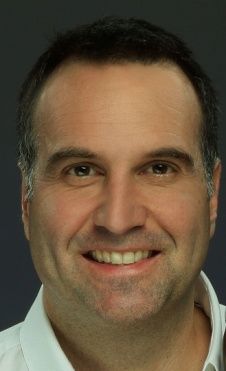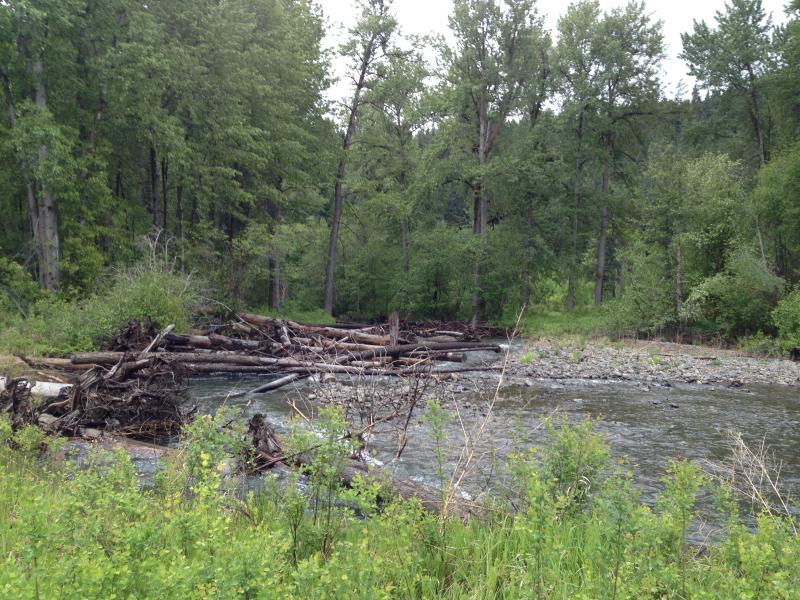Dr. Phil Roni and Dr. Stan Gregory were interviewed during the REFORM Final Conference and shared their views on river restoration in the US and Europe, on the importance of monitoring and the strengths of the REFORM project.
 Dr. Philip Roni has 25 years experience as a fisheries scientist and leads the Watershed Program at the NOAA Northwest Fisheries Science Center in the US, where he directs the research of more than 20 scientists conducting habitat research. At the REFORM Final Conference, Dr. Roni gave a keynote speech on “Key considerations for measuring river restoration success: Lessons from Western North America”.
Dr. Philip Roni has 25 years experience as a fisheries scientist and leads the Watershed Program at the NOAA Northwest Fisheries Science Center in the US, where he directs the research of more than 20 scientists conducting habitat research. At the REFORM Final Conference, Dr. Roni gave a keynote speech on “Key considerations for measuring river restoration success: Lessons from Western North America”.

Dr. Stan Gregory is an Emeritus Professor and Distinguished Professor of Fisheries in the Department of Fisheries & Wildlife at Oregon State University. He has studied streams, rivers, and lakes in the Pacific Northwest, and has been leading studies of the Willamette River for the last 20 years. At the REFORM Final Conference, he gave a keynote speech on “Anticipating future trajectories of floodplain rivers and human systems in river restoration.
In your opinion, what are the good elements about river restoration in Europe and in the US? How do the two continents compare to one another?
Stan: Overall, I think similarities between the two continents outnumber the differences. Our similarities in restoration approaches stem from the fundamental principles of hydrology, geomorphology and ecology, which are consistent between North America and Europe. The key concepts bind us together in a common framework; when advances are made in Europe which are based on those fundamental principles, we can apply them (or decide on the degree to which they can be applied) on our systems and vice-versa.
Over the last 20 years, there has been increasing interest and pressure in developing interdisciplinary approaches in northern Europe and in the US. We quickly learned that projects designed only by fish biologists were quite often weak, because they weren’t strong in the physical sciences; likewise we saw projects designed by engineers that were ecological nightmares. On both continents, we have acknowledged the importance of interdisciplinary and multidisciplinary approaches.
We also rediscovered some of the same kind of principles, such as the importance of conserving the healthy parts of our ecosystem. Sometimes we rush too quickly to restore and to put a bandage on a damaged part of the system, ignoring that we are losing a healthy part of the system. Sound landscaping and sound river management is a balance of conserving the healthy parts and restoring the damaged parts. That recognition is emerging on both continents.
The other aspect that is emerging on both continents is that people are part of rivers and landscapes and that we cannot restore river ecosystems separate from humans. Future hope lies in the commitment of the people who live along those rivers and are committed to keeping them healthy. So there is growing recognition of the importance of societies as an integral part of restoration and not something external to it.
If I could point to some differences, I would say that Europe is doing particularly well, in terms of the common context and structure provided by the European Union and the Water Framework Directive. As a result of EU funding for environmental research, I see wonderful collaborations between different countries and different cultures. It is fascinating to observe cultural influence on the way we view approaches for restoration. There is a certain degree of consistency, but at the same time I can see a different focus of restoration in the Netherlands, different approaches in Germany or France and a different spin in countries like Italy.
In addition, the development of information and data collectively and under a common framework in the EU right now is impressive, e.g. data on types of rivers, geomorphology, hydrology, water quality, pollutants, barriers, dams, fish communities and macro-invertebrates. This is a strength that I don’t see anywhere else in the world. The requirements for research projects like REFORM, to include a certain minimum number of EU countries and in the same time work with advisory boards with representatives from other continents is an extremely strong approach. In a way, I am quite envious of the integration, cultural and disciplinary diversity in EU projects!
In North America, one of the good aspects is the growth in interdisciplinary research which got an earlier and stronger start than in Europe. It is happening not because of a requirement but in a more inherent way, because we see the value in having multiple disciplines involved. Also some of the best reviews and early synthesis of information related to restoration came from the US. One of the things found in early synthesis work was that quite often we did not identify goals and objectives, and there was no guiding vision of restoration. I now see REFORM and other EU projects taking this earlier work to the next level. Another strength in the US, especially in terms of conservation and landscape level ecology, is the long term ecological program of the National Science Foundation with sites both in the US and around the world (including the Antarctica). These sites serve as an earth system observatory for a long period of time to support the development of long term ecological research.
Phil: It is hard to point out what is better in the US versus Europe. There are similar challenges to river restoration, and there are similar success stories in both places.
In the US, we have the general approach of giving funding to local groups to do restoration. The argument behind this grassroots approach is that the people that live in the catchments should know best. The problem with that is that local groups often do not have the larger perspective of the specific catchment or basin. Restoration tends to be very opportunistic, as local groups are constrained largely by what they can do quickly and who is going to go along with it (in terms of cooperation with land owners and local organizations). Local groups often start with a demonstration project with one land owner on board who is willing to cooperate and others follow later on, if they are convinced to join. And so it may take 10 to 15 years to get some of the really high priority projects realized and this is not because of technical obstacles. It is about education and building trust.
In addition, in the US, it is difficult to concentrate restoration efforts because there is the political tendency to spread funding across a region in many different watersheds. We call this the peanut butter approach, i.e. we get a little bit everywhere, instead of concentrating efforts in a few key watersheds. In my opinion, if we put a lot of effort for ten years into one place (watershed or sub-catcment), we could really make a big difference in terms of recovering a watershed or an endangered population of salmon or other fish. When you have a catchment of 500km of stream, and you restore 2 km, it is not enough to make a difference. It might make a difference in those 2 km, but you need to do much more to have a large response in the whole watershed, e.g. for a whole population of migratory fish, like salmon or eel.
In comparative terms, in Europe, you are much ahead of us when it comes to floodplain restoration, you’ve been re-meandering and pulling back levies for decades, because of the large amount of lowland rivers and floodplains that you have. We have spent a lot more time on smaller streams and headwater streams, because we have so a lot of public land mainly in mountainous areas. That has changed now and we are also working more on larger rivers.
Further, the WFD in Europe is a very strong tool and probably the most comprehensive legislation in the world for habitat protection. We are still struggling in that respect. The big drivers in the US are the Clean Water Act, which was passed in the early 70s and the Endangered Species Act (also in the early 1970s). The Clean Water Act looks at water quality and is primarily driven by temperature, pollutants, dissolved oxygen and sediment, but it does not include the biological components. A final point is that river restoration objectives in Europe try to integrate more people’s expectations, while in the US, we tend to try to restore rivers to pre-European conditions because of the availability of large areas of public lands, shorter history of human impacts, and availability of relatively pristine areas to serve as a target.

Photo: Placed logs in a stream to help restore in-channel habitat and reconnect floodplain wetlands in Washington State (photographer: Phil Roni)
Phil, in your keynote speech, you emphasized the importance of monitoring for successful restoration. How can we ensure that monitoring is done in a more efficient way?
Phil: In the US, the tendency has been to give funding to local groups to do the monitoring. The problem with this is that many local groups are very good at doing restoration, but not so good at doing the monitoring. It is done as an add-on, and over the years, a lot of money is spent on monitoring, but it does not really add up to much, because it is not well thought out.We have watershed councils and each one of those often does a different type of monitoring and uses different protocols. There is also not a lot of incentive for them to complete the monitoring and publish the results.
According to my experience, monitoring is better done by a third party that works together with the local groups. A third party can be a university, agency, or private consulting company. Sometimes private companies are more efficient at it, because they are more interested in doing what is defined in their contract. Universities often add their own research agenda on top of the monitoring and the monitoring programme can drifts away from its original objective (though this can happen with private companies as well!). The advantage of having a third party in charge of monitoring is also that it ensures monitoring gets the right priority and is done in a consistent way, especially in terms of having all data in a database that can be accessed by different groups later on.
Stan, on another note, could you give us your opinion on the key contribution of the REFORM project to river restoration science and practice?
Stan: REFORM exhibits very well the strength of EU programs in terms of interdisciplinary and cross-cultural comparisons. It is also very strong in developing guidelines for measurement approaches as well as conceptual frameworks for looking at hydrology, geomorphology, vegetation and aquatic biological communities. As we project our guiding vision into the future when implementing restoration projects, there is always a very fundamental uncertainty: Will restoration be effective and are we doing the right things? The strength of the REFORM work is in clearly stating the fundamental concepts, the framework and the guidelines for measurements, to give people guidance and understanding why restoration might be succeeding or failing and how restoration can be improved.
Another advantage of REFORM’s fundamental concepts clearly laid out in its framework is that this will provide a foundation for scientists to take the next steps beyond REFORM towards an even better approach for river restoration. The real question will be how much we will see people using the products of REFORM as a springboard, twisting them and creating something new in the next 5 to10 years.
As a final note, it is a challenge for REFORM to be able to release its concepts and results in a form that also decision makers, practitioners, the informed public and community groups can understand. However, I believe that REFORM has thought about this as well as including education as part of the project.
Phil Roni and Stan Gregory were interviewed on 30 June 2015 by Eleftheria Kampa (Leader of Dissemination and Stakeholder Involvement of REFORM, Ecologic Institute) at the REFORM Final Conference in Wageningen.

 Dr. Philip Roni has 25 years experience as a fisheries scientist and leads the Watershed Program at the NOAA Northwest Fisheries Science Center in the US, where he directs the research of more than 20 scientists conducting habitat research. At the
Dr. Philip Roni has 25 years experience as a fisheries scientist and leads the Watershed Program at the NOAA Northwest Fisheries Science Center in the US, where he directs the research of more than 20 scientists conducting habitat research. At the 















